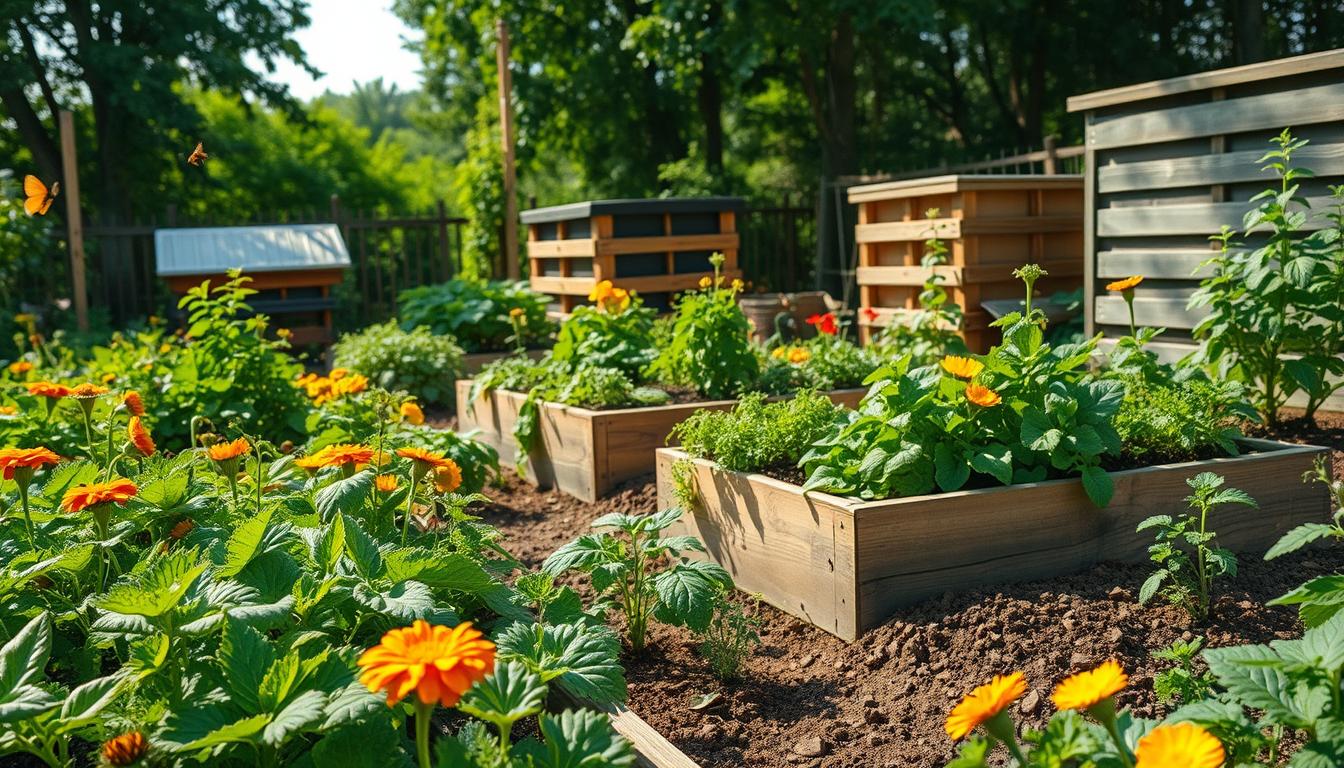I’m excited to share my journey of learning how to start an organic garden. I hope it will inspire you to create your own. As a beginner, I wanted to learn the basics of organic gardening tips.
I discovered that organic gardening is a sustainable and eco-friendly way to grow your own food. It’s becoming increasingly popular in the United States.
Through my experience, I’ve learned that having a beginner’s guide to organic gardening is essential. It’s not just about planting seeds. You also need to choose the right location, select organic seeds and plants, and prepare the soil for planting.
I’ll be sharing my secrets and tips on how to start an organic garden. I hope you’ll join me on this journey.
In this article, I’ll provide you with the knowledge and confidence to create your own organic garden. Whether you’re a seasoned gardener or just starting out, my goal is to make organic gardening accessible and fun for everyone. So, let’s get started and explore the world of organic gardening together!
Why I Chose to Start an Organic Garden
When I started gardening, I learned how vital organic gardening is. It makes the environment healthier and boosts my well-being. By using organic methods, I can keep my garden lush without harmful chemicals.
I chose organic gardening for its good effects on the planet. It keeps harmful chemicals out of our soil, air, and water. It also helps plants and animals live in harmony.
The Benefits of Going Organic
- Improved soil quality through the use of natural fertilizers
- Increased crop yields and better flavor
- Reduced exposure to toxic chemicals
Gardening lets me connect with nature and grow my own food. Organic gardening helps me care for my plants and protect the environment. It’s great for both new and experienced gardeners.
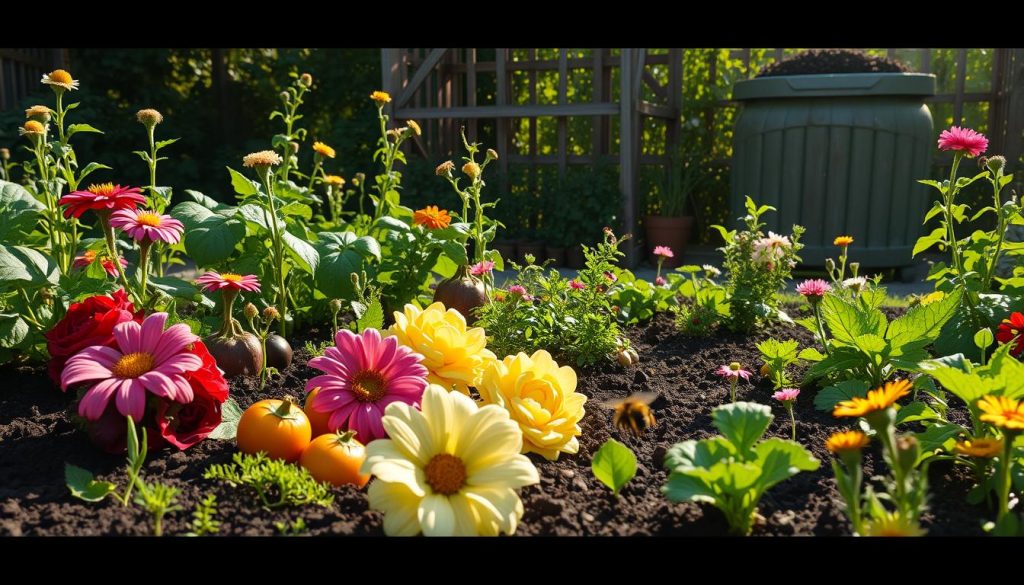
Choosing the Right Location for My Garden
Starting an eco-friendly garden means picking the perfect spot. The location affects how well my plants grow and stay healthy. I need to think about sunlight, soil quality, and shade.
I look at my yard to find the best sunlight spot. Most plants need at least 6 hours of direct sunlight daily. The soil should drain well and be full of organic matter. Bad soil can harm my plants.
Sunlight Requirements
Each plant needs different sunlight levels. Leafy greens like lettuce can handle some shade. But tomatoes and peppers need full sun. I list my plants and their sunlight needs to pick the right spot.
Soil Quality Considerations
Soil quality is key. I test my soil to see its pH and nutrient levels. If it’s off, I add compost or manure. This step is vital for a healthy garden.
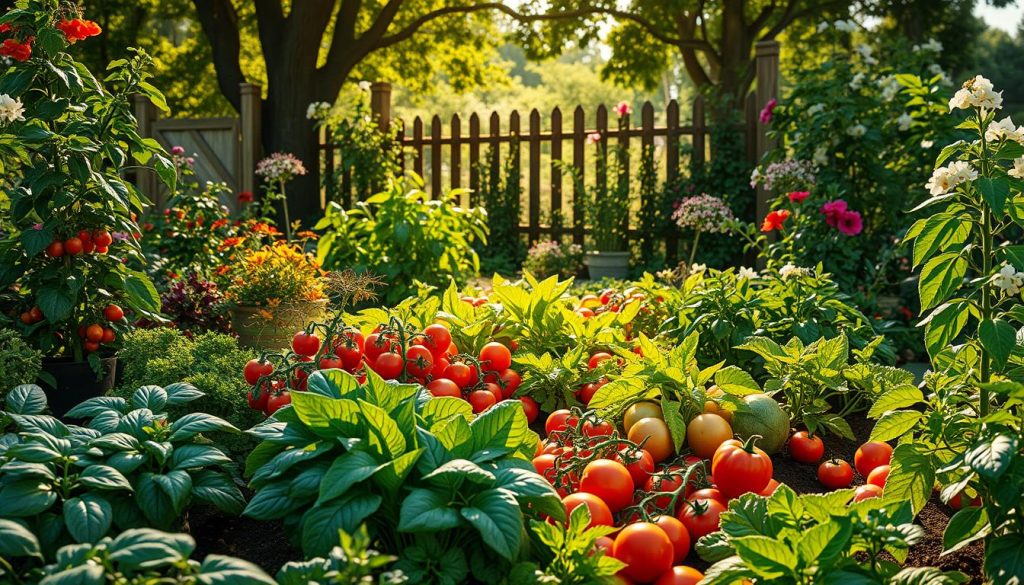
Dangers of Too Much Shade
Too much shade is bad for plants. It makes them weak and prone to disease. I choose spots with good sunlight and air flow.
Planning My Organic Garden Layout
Planning your organic garden layout is key. A well-thought-out garden boosts yields and cuts down on upkeep. For beginners, think about companion planting and vertical gardening to make the most of your space.
Companion planting is vital. It means pairing plants that help each other. For instance, marigolds with tomatoes keep nematodes away. Basil and mint can also enhance the taste of nearby veggies.
Companion Planting Techniques
- Plant marigolds with tomatoes to deter nematodes
- Pair basil and mint with vegetables to improve flavor
- Use nasturtiums to repel aphids and whiteflies
Maximizing Space with Vertical Gardening
Vertical gardening saves space in your garden. Use trellises, arbors, or wall planters for vining plants like cucumbers and peas. It also cuts down on soil erosion and boosts air flow, helping plants grow well.
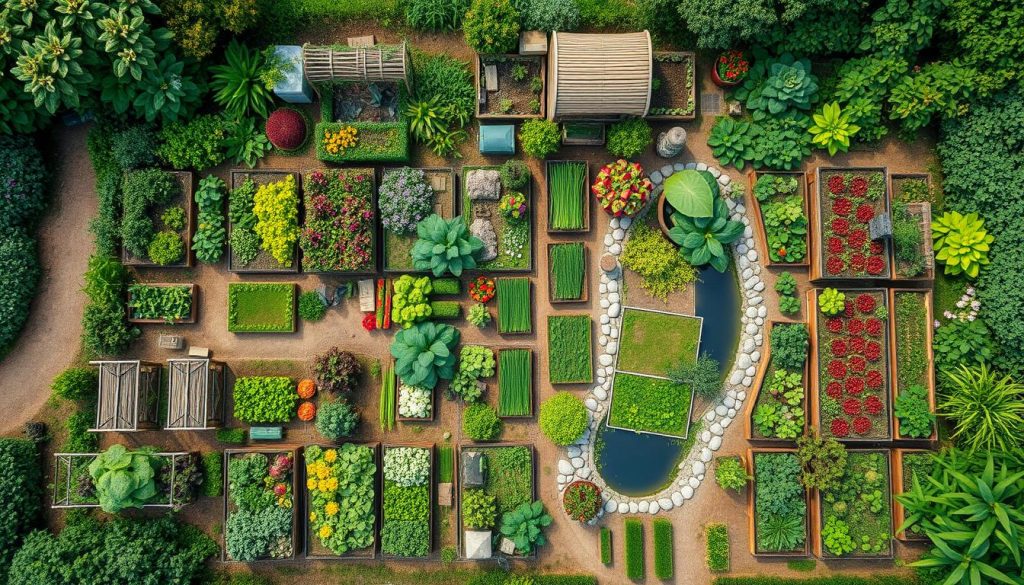
By using these organic gardening tips, you can design a garden that’s both functional and beautiful. It will flourish and give you fresh, organic food.
| Plant | Companion Plant | Benefit |
|---|---|---|
| Tomatoes | Marigolds | Deter nematodes |
| Cucumbers | Dill | Improve flavor |
| Carrots | Sage | Repel pests |
Selecting Organic Seeds and Plants
Starting an organic garden means picking the right seeds and plants. As a beginner, I’ve found that the right choices are key. They help my plants grow healthy and strong, giving me fresh, chemical-free food.
I think about my garden’s climate and soil when picking seeds and plants. This helps me find the best fit for my garden. I also look for guides that offer tips and solve common problems.
Where to Shop for Seeds
There are many places to buy organic seeds and plants. You can find them online or in local stores. I prefer brands like Seed Savers Exchange and High Mowing Seeds for their quality.
Heirloom vs. Hybrid Seeds
Choosing between heirloom and hybrid seeds is important. Heirloom seeds are great for saving and replanting. Hybrid seeds might have better traits like disease resistance. Knowing the differences helps me pick the best for my garden.
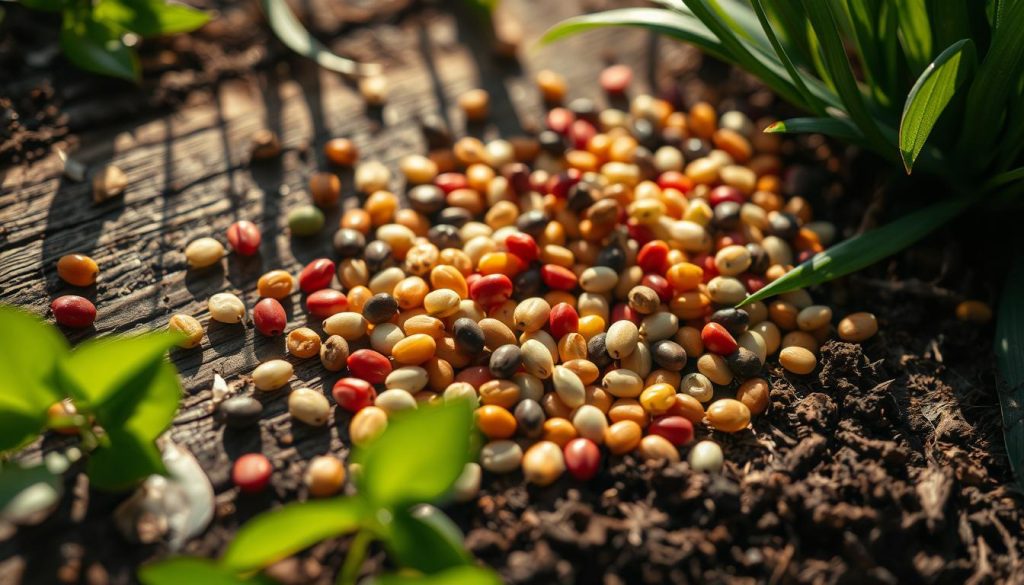
By following these tips, I’ve made my garden a success. It’s rewarding to grow healthy food for my loved ones. I hope these suggestions help you in your organic gardening journey, whether you’re new or experienced.
Preparing My Soil for Planting
To make my organic garden grow well, I need to get my soil ready. This means checking the soil’s pH and nutrients and adding organic matter. These steps help create a soil environment that supports my plants’ growth.
Starting an eco-friendly garden means paying attention to the soil’s makeup. I can test my soil’s pH and nutrients with a DIY kit or by sending a sample to a lab. This helps me understand what my soil needs, so I can make the right changes.
Testing Soil pH and Nutrients
Checking my soil’s pH and nutrients is key to getting it ready for planting. The test results tell me which gardening methods will work best for my garden. For example, if my soil is too acidic, adding lime might be necessary.
When testing my soil, I look at a few important factors:
- pH level
- Nitrogen content
- Phosphorus content
- Potassium content
Amending Soil with Organic Matter
After testing, I can add organic matter like compost or manure to my soil. This improves the soil’s structure and fertility, helping my plants grow better. Using these methods, I can make my garden healthy and productive.
By following these tips and using sustainable gardening methods, I can have a beautiful and productive garden. Whether starting from scratch or improving an existing garden, these tips help me achieve my goals and create a thriving space.
| Soil Amendment | Benefits |
|---|---|
| Compost | Improves soil structure and fertility |
| Manure | Adds nutrients and improves soil health |
| Lime | Raises soil pH and improves nutrient availability |
Essential Tools for My Organic Garden
Starting an organic garden? The right tools are key to success. As a beginner, you’ll need must-have gardening tools. These will help you care for your garden. I’ll talk about the tools you need, including eco-friendly options.
For beginners, start with the basics. You’ll need gloves, pruners, and a watering can. These help with daily tasks like watering and pruning. Also, look into eco-friendly options like bamboo handles and biodegradable twine.
Must-Have Gardening Tools
- Gloves: to protect your hands from thorns and dirt
- Pruners: to trim and prune your plants
- Watering can: to water your plants efficiently
Eco-Friendly Alternatives
Think about the environmental impact of your tools in organic gardening. Eco-friendly options like bamboo handles and biodegradable twine reduce waste. They help make your garden more sustainable.
Investing in the right tools and eco-friendly options will help your garden thrive. Always follow organic gardening tips for a healthy and productive garden.
Watering Practices That Work for Me
As I explore organic gardening, I’ve learned how crucial good watering practices are. The best organic gardening tips stress saving water while keeping plants moist. Using drip irrigation and soaker hoses are key steps to follow.
These methods water plants right at their roots. This cuts down on water lost to evaporation and runoff. Plus, using rainwater helps cut down on the need for city water.
Efficient Irrigation Techniques
- Drip irrigation: delivers water directly to the roots of the plants, reducing evaporation and runoff
- Soaker hoses: allow for targeted watering, minimizing waste and ensuring plants receive the right amount of moisture
Rainwater Harvesting
Collecting rainwater is also vital for efficient watering. It saves money on water bills and gives plants pure water. This is great for organic gardens since it avoids harmful chemicals in city water.
These watering practices help my garden grow well. It’s not just about growing food; it’s about helping the planet too. Whether you’re new to organic gardening or have been doing it for years, these tips can really help.
| Watering Method | Benefits |
|---|---|
| Drip Irrigation | Reduces evaporation and runoff, delivers water directly to roots |
| Soaker Hoses | Minimizes waste, provides targeted watering |
| Rainwater Harvesting | Reduces water bill, provides natural and chemical-free water source |
Pest Management in My Organic Garden
As I care for my organic vegetable garden, I’ve learned how key pest management is. It keeps the garden balanced. To start an eco-friendly garden, using natural methods is best. This includes introducing helpful insects or organic sprays.
Common pests like aphids, slugs, and snails can harm my garden. To fight them, I use soapy water or neem oil. I also attract beneficial insects like bees and ladybugs. They pollinate and control pests.
- Companion planting: Some veggies or herbs keep pests away when planted together.
- Physical barriers: Fine mesh or netting stops pests from reaching my plants.
- Organic sprays: Sprays from garlic or hot peppers repel pests.
These natural methods help my garden thrive. They also follow organic gardening tips. This way, my garden is good for the environment.
Harvesting My Organic Produce
After months of caring for my organic garden, it’s time to enjoy the fruits of my labor. Harvesting is a thrilling part of gardening. With the right methods, I can enjoy my fresh produce for a longer time. To start, I need to follow a beginner’s guide to organic gardening.
When I start harvesting, I must think about how to store my produce. I’ll use the right containers and keep them cool and dry. Regular checks are also key. These steps help keep my produce fresh and of high quality.
When to Harvest Different Vegetables
- Tomatoes: when they’re fully red and have a slight give when pressed
- Carrots: when they’re between 1/2 to 1 inch in diameter
- Lettuce: when the leaves are crisp and reach the desired size
Best Practices for Storing My Harvest
To keep my harvest fresh, I’ll store it in a cool, dry place. It should be away from direct sunlight. Regular checks help remove any spoiled produce. By following these steps, I can enjoy my homegrown produce longer and share it with loved ones.
Sharing My Organic Gardening Journey
I’m thrilled to share my organic gardening story with those who love growing food the green way. Connecting with local gardeners has been key to my growth. We swap tips and stories, learning from each other and improving our gardening skills.
Connecting with Local Gardening Communities
Working with others in my community has been incredibly rewarding. I’ve joined gardening clubs and workshops. There, I’ve picked up new ideas and techniques for growing food organically.
Resources for Organic Gardening Enthusiasts
If you’re eager to learn more about organic gardening, there’s a lot out there. Books, forums, and videos are all great resources. I’m excited to see more people join the organic gardening movement.

